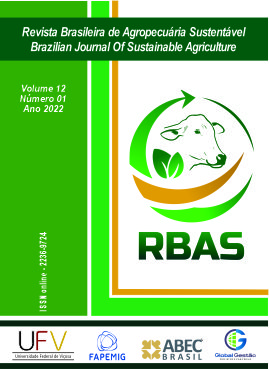Re-ensiling and microbial inoculant use effects on the quality of maize silages exposed to air
DOI:
https://doi.org/10.21206/rbas.v12i1.13683Palabras clave:
aerobic deterioration, farm management, Lactobacillus plantarum, Propionibacterium acidipropionici, silage relocationResumen
Re-ensiling has increased worldwide due to the increase in marketing of silage between farms. However, litlle is known about the aerobic deterioration and microbial inoculants effect in this process. The aim of this study was to determine the re-ensiling and microbial inoculant use effects on the maize silage quality. Experimental treatments included maize silage exposed to air for zero or 18 h, with or without microbial inoculant use containing a mixture of Lactobacillus plantarum and Propionibacterium acidipropionici. The forage was ensiled in 20 plastic buckets (20 liters capacity) with five repetitions per treatment. The silos were opened after 116 days and the chemical composition, in vitro dry matter digestibility (IVDMD), fermentative parameters, microorganism counts, total dry matter (DM) losses and aerobic stability of silage were evaluated. Re-ensiling reduced the non-fibrous carbohydrates content by 14.8%, whereas it increased the neutral detergent fiber content by 6%. The IVDMD was reduced by 6.1% in re-ensiled silages. In addition, re-ensiling increased the losses due to gases, effluents, and total DM. Lower lactic acid content and higher acetic acid content in re-ensiled maize silages were also observed. However, IVDMD increased by 4.6% in inoculated silages. Re-ensiling reduced the nutritive value and IVDMD of maize silages and should be avoided in production systems. The microbial inoculant use was not effective in improving the re-ensiled silage quality, which does not justify its use in these conditions. Farms should avoid purchasing maize silage due to reduction in nutritional value in the re-ensiling process. However, in some cases where farms need to purchase silage for feeding planning, the time between silo opening and re-ensiling should be as short as possible to reduce nutrient loss. Furthermore, in this situation the inoculant use does not improve silage conservation, which makes its use unnecessary.
Descargas
Descargas
Publicado
Cómo citar
Número
Sección
Licencia
Derechos de autor 2022 Brazilian Journal of Sustainable Agriculture

Esta obra está bajo una licencia internacional Creative Commons Atribución-NoComercial-SinDerivadas 4.0.
1. Proposta de Política para Periódicos de Acesso Livre
Autores que publicam nesta revista concordam com os seguintes termos:
Autores mantém os direitos autorais e concedem à revista o direito de primeira publicação, com o trabalho simultaneamente licenciado sob a Licença Creative Commons Attribution que permite o compartilhamento do trabalho com reconhecimento da autoria e publicação inicial nesta revista.












